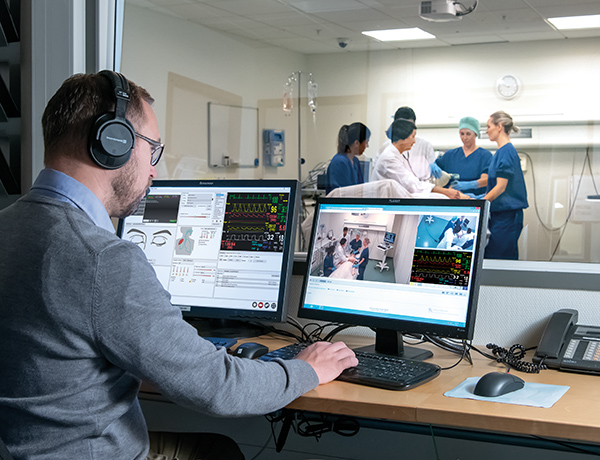Simulation is a modern and experiential learning style that allows medical students and healthcare professionals to get medical training and develop clinical skills. During simulation training, students get an amazing opportunity to test their knowledge by working in real-world healthcare scenarios. Healthcare simulation is one of the best learning techniques that can boost confidence among students. Whether you are an undergraduate student or postgraduate student, simulation training can prepare you for many emergency situations.
The goal of this fundamental learning strategy is to provide medical students a safe environment to practice their clinical skills without putting a patient’s health at risk. It has been used as an effective learning technique in many healthcare systems, medical schools, nursing institutes for education, research, and experimentation purposes.
Many medical schools, training institutions and health centers incorporate simulation to provide clinical training to students and professionals. In fact, simulation training programs are a convenient option for medical schools and health centers to train future doctors by deliberate practice, feedback, and debriefing.
Let’s explore why simulation learning is important and how it plays a key role in healthcare education.
What is Medical Simulation?
Medical simulation or clinical simulation is an experiential learning method that mimics a clinical situation without the risk of any harmful clinical outcome. A safe and controlled environment is provided to allow students, healthcare workers, and nurses to practice clinical skills. It boosts their confidence and allows them to learn from their mistakes without the fear of harming a real-life patient and other consequences.
Clinical simulations can create multiple scenarios, allowing students to understand how to handle complex medical situations. Besides learning life-saving procedures, medical simulation can develop your cognitive thinking, and problem-solving skills. The learning approach prepares students and new doctors to succeed in their future career paths.
Advantages of Simulation Learning in Healthcare
Whether you want to become a paramedic, doctor, or nursing professional, clinical simulation is important for building certain skills you need to succeed in a hospital or clinical environment. Here are some benefits of simulation learning in healthcare education.
Develop Important Skills
A simulated learning environment can help you learn a range of skills that you need to become a good physician, nurse, or healthcare professional. Whether it’s providing wound care, lifting, CPR, or injecting, taking part in a realistic simulated learning environment can better prepare you to perform at your best.
Knowledge of Different Medical Procedures
Simulation training is so close to the real scenario, allowing health clinicians to prepare for their future careers. Beginners can use this advanced learning technology to gain confidence for performing different medical procedures and clinical tasks that they are expected to perform in real healthcare settings. You can test your knowledge by making mistakes and reviewing what you can perform and what you need to learn. You will learn how to perform minimally invasive surgeries, catheter-based therapies, and different other medical procedures.
Helps You Treat Complex and Rare Diseases
Clinical simulation helps medical students learn how to treat patients with complex and rare diseases. When you are inexperienced or new to the medical field, it is not possible to practice treating a real person with a rare disorder or critical condition. However, simulation training allows you to provide a safe clinical environment where you can learn how to treat different medical conditions. Simulation can offer beginners and inexperienced persons access to events, tools, and devices that they can use in a safe and controlled environment to treat the patient.
Prepare for the Real-Life Healthcare Settings
It is one of the main reasons medical schools use clinical simulation as an important part of the education system. Students can use simulation to practice different diagnostic procedures and manage clinical situations. Whether it’s practicing birth on the manikins, giving any obstetric emergency treatment or handling any other life-threatening condition. Simulated learning provides a controlled safe environment for students. This advanced learning approach provides trainees a great opportunity to build their competence and confidence and learn how to address errors in real-time.
Prepare You for a Rewarding Medical Career
With a simulated learning environment, medical schools can produce well-rounded, knowledgeable medical professionals that can serve humanity. From audiovisual recording systems to virtual anatomy simulations, manikin-based simulations to tissue-based simulators, a huge range of simulation models allow students to strengthen their academic concepts by learning practice tasks and processes in lifelike circumstances.
Ensuring Patient Safety
The patient’s safety and care are the ultimate goal of clinical simulation. This is why many Caribbean medical school, nursing institutes and health centers focus on offering a simulated learning environment. It helps medical students learn how to work in a clinical environment and ensure patient’s safety. Medical errors are one of the leading causes of death in Canada, the United States, and other countries. A survey conducted by the Canadian Institute for Health Information found that medical errors are responsible for approximately 23,750 deaths per year.
This is why patient safety has now become one of the major concerns for nearly all health disciplines. To ensure patient safety, simulation-based learning is considered as a great learning effective technique that ensures a safe, controlled environment. By working in a clinical simulation environment, students are allowed to make elementary mistakes without causing real harm to patients.
Prepare You for Stressful Situations
One of the major benefits of providing students with a simulated learning environment is to prepare them to work in high-intensity circumstances. It allows students to coordinate with other team members under stress, manage intensive workloads, and work in group settings.
Over to You
With the advent of the latest technologies, such as virtual reality and augmented reality training tools, and 3D apps, providing simulated learning has now become easier for medical schools. These learning technologies and tools provide medical students with the opportunity to get training in different simulated environments, perform well in a Caribbean medical school and prepare for a challenging medical career.



